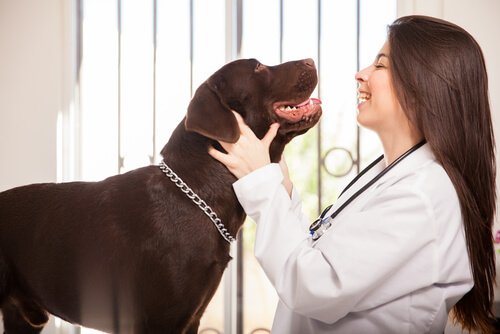What is Acute Abdomen in Dogs?


Written and verified by the lawyer Francisco María García
Acute abdomen in dogs often causes a lot of pain and is usually associated with diseases like canine peritonitis. It’s really important to diagnose it at an early stage to apply effective and immediate treatment. Therefore, read this article to find out more about acute abdomen in dogs, its symptoms and its causes.
Acute abdomen in dogs: What it is and how does it develop?
Acute abdomen is usually considered to be more of a complex symptom than a pathology. It consists of a series of symptoms such as acute pain, diarrhea, abdominal distension, vomiting, malnutrition, weakness, depression, etc.
As you can see, acute abdomen in dogs is almost always associated with acute pathologies that are related to the abdominal cavity. Among them, the one that most frequently affects dogs of all ages is canine peritonitis.

However, sometimes, acute abdomen appears due to certain chronic pathologies that impair the abdominal organs.
What is canine peritonitis?
Peritonitis is an acute and sudden inflammation that attacks the tissues of the abdominal cavity (or peritoneum). As a result, the body accumulates a huge amount of fluid in the peritoneal region, which causes remarkable swelling.
This intense water retention also often leads to severe dehydration and an electrolyte imbalance. This is why it’s necessary to be aware of the symptoms and immediately take your dog to the vest as soon as you notice any complications in your pet.
Normally, canine peritonitis progresses very rapidly in the body, which is many dogs arrive at veterinary clinics in shock or in a coma. In these cases, before proceeding with the assessment, it’s very likely that the veterinarian will immediately begin anti-shock therapy.
Symptoms of acute abdomen in dogs
The first visible signs of acute abdomen in dogs are normally not very specific, but they are recognizable. At first, the dog is constantly tired, pants, and they have a lack of appetite. Afterward, they usually experience tremors and cry or constantly whine due to their abdominal pain.
The following symptoms appear as canine peritonitis progresses:
- Lethargy.
- Changes in posture and the way the dog lies down: It’s common for dogs to try to find a position in which the pain bothers them less.
- Abdominal swelling and/or the abdomen being hard to the touch.
- Acute pain: Many dogs will cry in pain with a simple touch or brush against their abdomen.
- Diarrhea: Normally black (melaena).
When the inflammation adversely affects the intestines and stomach, it often causes frequent vomiting. Also, many dogs also will get a fever.
As in most pathological conditions, the symptoms of canine peritonitis become worse when the disease advances. In many cases, the dog arrives at the veterinarian already in shock.
Thus, we emphasize the importance of early diagnosis in order to allow effective treatment and avoid severe complications. Consequently, it is essential to immediately contact your veterinarian upon observing any of the symptoms described above.
The causes of acute abdomen in dogs
Most diagnoses of acute abdomen in dogs are related to endogenous and infectious causes, such as:
- Viruses that affect the stomach and/or intestines.
- ‘Stomach flu’ (or viral gastroenteritis).
- Canine peritonitis.
- Intestinal or stomach endoparasites.
- Urinary infections (usually bacterial).
- The presence of holes in the stomach or intestines.
- Abscesses in the spleen, liver, pancreas or intestines.
Noninfectious causes of acute abdomen in dogs
Many dogs may have acute abdomen due to non-infectious or exogenous factors, such as:
- Poisoning.
- Certain types of tumors.
- Diseases or congenital deformities.
- Trauma in the abdominal region.
- An abdominal hernia.
- Gastric dilatation.
- Kidney stones or gallstones.

Treating acute abdomen in dogs
Treatment should be determined by the veterinarian after diagnosing the cause of a dog’s acute abdomen. The medication and procedures will be focused on combating or managing the disease that has led to this symptom.
Generally, intravenous therapies are applied to combat dehydration and malnutrition. Analgesics can also be administered to relieve the intense pain the dog experiences.
Since the pathologies that are associated with this disease tend to advance rapidly, surgical intervention becomes necessary in a large number of cases.
Acute abdomen in dogs often causes a lot of pain and is usually associated with diseases like canine peritonitis. It’s really important to diagnose it at an early stage to apply effective and immediate treatment. Therefore, read this article to find out more about acute abdomen in dogs, its symptoms and its causes.
Acute abdomen in dogs: What it is and how does it develop?
Acute abdomen is usually considered to be more of a complex symptom than a pathology. It consists of a series of symptoms such as acute pain, diarrhea, abdominal distension, vomiting, malnutrition, weakness, depression, etc.
As you can see, acute abdomen in dogs is almost always associated with acute pathologies that are related to the abdominal cavity. Among them, the one that most frequently affects dogs of all ages is canine peritonitis.

However, sometimes, acute abdomen appears due to certain chronic pathologies that impair the abdominal organs.
What is canine peritonitis?
Peritonitis is an acute and sudden inflammation that attacks the tissues of the abdominal cavity (or peritoneum). As a result, the body accumulates a huge amount of fluid in the peritoneal region, which causes remarkable swelling.
This intense water retention also often leads to severe dehydration and an electrolyte imbalance. This is why it’s necessary to be aware of the symptoms and immediately take your dog to the vest as soon as you notice any complications in your pet.
Normally, canine peritonitis progresses very rapidly in the body, which is many dogs arrive at veterinary clinics in shock or in a coma. In these cases, before proceeding with the assessment, it’s very likely that the veterinarian will immediately begin anti-shock therapy.
Symptoms of acute abdomen in dogs
The first visible signs of acute abdomen in dogs are normally not very specific, but they are recognizable. At first, the dog is constantly tired, pants, and they have a lack of appetite. Afterward, they usually experience tremors and cry or constantly whine due to their abdominal pain.
The following symptoms appear as canine peritonitis progresses:
- Lethargy.
- Changes in posture and the way the dog lies down: It’s common for dogs to try to find a position in which the pain bothers them less.
- Abdominal swelling and/or the abdomen being hard to the touch.
- Acute pain: Many dogs will cry in pain with a simple touch or brush against their abdomen.
- Diarrhea: Normally black (melaena).
When the inflammation adversely affects the intestines and stomach, it often causes frequent vomiting. Also, many dogs also will get a fever.
As in most pathological conditions, the symptoms of canine peritonitis become worse when the disease advances. In many cases, the dog arrives at the veterinarian already in shock.
Thus, we emphasize the importance of early diagnosis in order to allow effective treatment and avoid severe complications. Consequently, it is essential to immediately contact your veterinarian upon observing any of the symptoms described above.
The causes of acute abdomen in dogs
Most diagnoses of acute abdomen in dogs are related to endogenous and infectious causes, such as:
- Viruses that affect the stomach and/or intestines.
- ‘Stomach flu’ (or viral gastroenteritis).
- Canine peritonitis.
- Intestinal or stomach endoparasites.
- Urinary infections (usually bacterial).
- The presence of holes in the stomach or intestines.
- Abscesses in the spleen, liver, pancreas or intestines.
Noninfectious causes of acute abdomen in dogs
Many dogs may have acute abdomen due to non-infectious or exogenous factors, such as:
- Poisoning.
- Certain types of tumors.
- Diseases or congenital deformities.
- Trauma in the abdominal region.
- An abdominal hernia.
- Gastric dilatation.
- Kidney stones or gallstones.

Treating acute abdomen in dogs
Treatment should be determined by the veterinarian after diagnosing the cause of a dog’s acute abdomen. The medication and procedures will be focused on combating or managing the disease that has led to this symptom.
Generally, intravenous therapies are applied to combat dehydration and malnutrition. Analgesics can also be administered to relieve the intense pain the dog experiences.
Since the pathologies that are associated with this disease tend to advance rapidly, surgical intervention becomes necessary in a large number of cases.
All cited sources were thoroughly reviewed by our team to ensure their quality, reliability, currency, and validity. The bibliography of this article was considered reliable and of academic or scientific accuracy.
Galezowski, A. M., Snead, E. C. R., Kidney, B. A., & Jackson, M. L. (2010). C-reactive protein as a prognostic indicator in dogs with acute abdomen syndrome. Journal of Veterinary Diagnostic Investigation. https://doi.org/10.1177/104063871002200308
Ruaux, C. G. (2003). Diagnostic approaches to acute pancreatitis. Clinical Techniques in Small Animal Practice. https://doi.org/10.1016/S1096-2867(03)00072-0
This text is provided for informational purposes only and does not replace consultation with a professional. If in doubt, consult your specialist.








